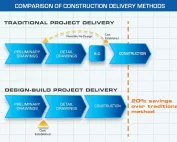Most snow-related building losses typically occur at stepped elevations where blowing snow is carried from an upper roof down to a lower roof.
The winter season is upon us in Northern Indiana and there is no accurate way for us to predict what the winter will bring. If we have a repeat of recent years, there are a few things every building owner should know to prevent a catastrophe from occurring:
- Heavy and repeated snowstorms can create packed snow and ice conditions resulting in unusual and excessive snow loads of 50 p.s.f. or greater.
- Blowing and drifting snow can add to these loads
- Rain-on-snow can cause significant load increases
- These loads can be in excess of the design capacity of the building and can cause damage, collapse, or at worst, business interruption, injury and death.
The longer snow sits on your roof, the heavier it tends to get. Why?
Snow melts and turns to ice. As this process repeats itself with each snowfall, additional weight is added to your roof. This excess weight is not intended to be sustained by your roof for extended periods of time and can lead to structural damage—both visible and non-visible. Modifications to the structure, loads added after the original design and previous damage to the building are also areas of concern, as they may have already reduced the capacity of your roof to carry additional snow loads.
What To Look For
Most snow-related building losses typically occur at stepped elevations where blowing snow is carried from an upper roof down to a lower roof. This usually occurs where a lower structure is directly attached to a taller structure. Warning signs on the inside of the building include deflection of purlins or structural members, popping of ceiling tiles in dropped ceilings and unusual noises.
What To Do
Many building owners and facilities managers are unaware of the damage that can occur when excessive snow accumulation is present. However, there are a few things that can be done to help prevent damage this winter:
- Activate a snow watch and removal crew to monitor snow depths.
- Remove excessive snow/ice accumulation with snow rakes and a snow melt system.
- Keep drains and gutters clear of ice and snow to facilitate melting run-off. Ice build-up can cause excessive loads without great depths.
- Install heat tape in gutters and downspouts to eliminate ice build-up.
How To Deal With A Near Collapse
If a roof is in danger of collapse, the building should be evacuated immediately, and the following emergency procedures are recommended:
- Contact a professional who is equipped to deal with this type of situation.
- In many cases, the shoring of purlins or structural members is the most effective solution.
- If shoring is not feasible or possible, removing the snow or ice buildup may be sufficient.
- Large industrial heaters inside the building may also assist in melting rooftop snow and ice.
- The best method for dealing with a problem of this magnitude is prevention.
When it comes to excessive snow and ice loads, the most important concern is the safety of the employees in your building. If you have any doubts that your roof may be in jeopardy, we urge you to err on the side of caution and take preventative measures quickly.
If you have questions about snow and ice loads, feel free to give
J.A. Wagner Construction a call at 574-295-3761 or email Andrew Harman at
Andrew@jawagner.com. We are happy to help you deal with Mother Nature and all she has to throw at us this winter.
Contact us today!
About J.A. Wagner Construction
J.A. Wagner is an award-winning design-build contractor and Butler Builder®. Our work can be found throughout the United States. Projects in Indiana, Ohio, Michigan, Kentucky, Tennessee, Florida, Utah and Texas illustrate the confidence clients have placed in us to construct their facilities.
Cost-effectiveness and ease to work with are primary reasons clients have chosen J.A. Wagner for their projects over the services of local builders in these regions.







